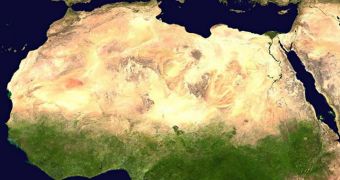The giant desert we see on the world map spanning north and central Africa did not always look like this. Sahara was once a lush grassland, where herds roamed free and rivers ran rich with water. Finding out exactly how the change took place might yield clues to Earth's future.
The general belief among experts is that slight changes in the tilt of our planet's rotation axis caused the desertification of this huge area. While most scientists agree with this interpretation, disagreements appear when scientists try to settle when this happened, and over how much time.
In a recent research, presented earlier this year at the European Geosciences Union General Assembly, in Vienna, Austria, experts brought forth new evidence to support the idea that the desert developed gradually, and at a slow pace.
The findings hold especially true for the area near Lake Yoa in Chad, which geologists determined underwent a slow transformation starting from the mid-Holocene period.
“The findings of this study are that the sedimentological and geochemical properties of the lake sediments confirm that the Sahara has been drying slowly from six thousand years ago to reach the present day conditions around 1,100 years ago,” explains Pierre Francus.
He was the lead author of the research. Francus is a professor at the National Institute of Scientific Research, in Quebec, Canada, Space reports.
According to experts at the NASA Goddard Institute for Space Studies (GISS), the study hold. Gavin Schmidt, a climate scientist with the organization, says that Earth had a different axis tilt 8,000 years ago than it does today.
After that time, the tilt changed from 24.1 degrees to 23.5 degrees. “Additionally, the Earth had its closest approach to the Sun in the northern hemisphere (with) summer in August,” Schmidt adds.
“Today, that closest approach is in January. So, summertime in the north was warmer back then than it is now,” he goes on to say, adding that his group's calculations were confirmed by analysis of sediments collected from the deep sea.
“If you get a long enough time series that can be well dated, you should be able to see frequencies in the data that correspond to the periods predicted by theory,” he adds.
What's interesting to note here is that the planetary tilt is currently changing as well, but not on account of the standard, 41,000-year variation, but because of human-induced global warming.
As the weight of the glaciers pushing down of Greenland is lifted, the tilt is modified by as much as 2.6 centimeters annually. Experts at the NASA Jet Propulsion Laboratory (JPL) say that the rate will increase in coming years.
And this is where the Sahara connection comes in. What researchers showed with the recent study was that slight changes in Earth's axial tilt can cause abrupt changes in ecosystems.
“Given the very strong dependence of vegetation on water availability, the end of the 'Green Sahara' came about quite suddenly around 5,500 years ago,” Schmidt explains.
“Thus, a very slow change in the orbit (led) to an abrupt collapse in that ecosystem,” he adds.
“We cannot rule out completely the possibility of abrupt drying. Understanding the regional differences in climate change is the next challenge for climate scientists,” Francus concludes.

 14 DAY TRIAL //
14 DAY TRIAL //